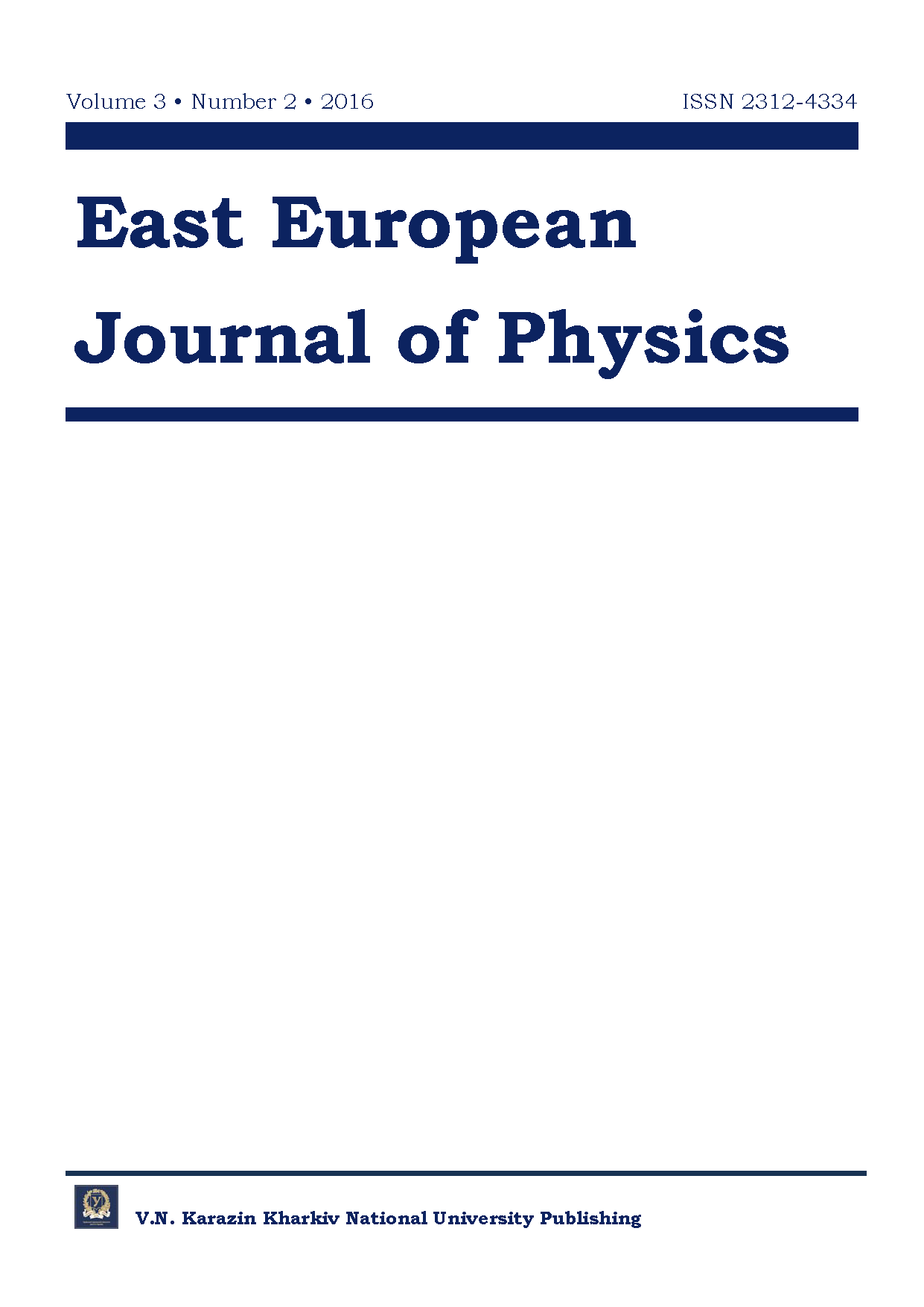INFLUENCE OF THE ADDITIVES OF THE THIRD ELEMENT IN ALLOY Cu-Ti ON ENERGY OF THE SEGREGATION OF THE IMPURITY DURING CELLULAR PRECIPITATION OF THE SOLID SOLUTION
Abstract
The mathematical analysis of influence of additives of the third component (Cr, Mn, Fe, Co, Ni, Ga, Zr, In, Sn) on quantities of energies of a segregation of impurities in volume and on boundaries of grains of alloy Cu-4,35 at. % Ti is made during aging on the cellular mechanism. Calculation of enthalpies of a segregation is spent with the account of energies of interatomic and elastic interaction of atoms of a different grade. Effects of experimental researches testify, in particular, to effective accelerating influence Ni on development of cellular decay in alloy Cu-4,35 ат. % Ti and essential inhibiting action of the given process by an additive Co. On the basis of modelling calculations of enthalpies of mixture in volume and on boundaries of grains it is erected that for the specified additives distinctions in quantities of an enthalpy of mixture in volume of grains appear considerable. The carried out analysis can be taken as a principle build-ups of model of a dynamic segregation and its influence on velocity of cellular decay in threefold metal systems.
Downloads
References
Larikov L.N., Shmatko O.A. Jacheistyj raspad peresyshhennyh tverdyh rastvorov. – K.: Naukova dumka, 1976. – 259 s.
Zieba P. Local Characterization of Chemistry and Kinetics in Discontinuous Solid State Reactions. Cracow : Polish Academy of Sciences, Institute of Metallurgy and Material Science, 2001. – 368 p.
Kirchheim R. Grain coarsening inhibited by solute segregation // Acta mater. – 2002. – Vol. 50. – P. 413-419.
Darling K.A., van Leeuwen B. K., Koch C. C., Scattergood R. O. Thermal stability of nanocrystalline Fe-Zr alloys // Mater. Sci. Eng. A. – 2010. – Vol. 527. – P. 3572-3580.
Lejček P. Grain Boundary Segregation in Metals. – Heidelberg, Germany: Springer, 2010. – 252р.
McLean D. Grain Boundaries in Metals. – London: Oxford Univ., 1957. – 346 p.
Wynblatt P., Chatain D. Anisotropy of Segregation at Grain Boundaries and Surfaces // Metall. and Mat. Trans. A. – 2007. - Vol. 38. – No. 2. – P. 438 – 439.
Wynblatt P., Ku R.C. Surface energy and solute strain energy effects in surface segregation // Surface Science. – 1977. – Vol. 65. – P. 511-523.
Guttman M. Grain boundary segregation, two dimensional compound formation, and precipitation // Met. Trans. A. – 1977. - Vol. 8. – No. 9. – P. 1383 - 1401.
Cahn J.W. The impuvity-drag effect in grain boundary motion // Acta Met. – 1962. - Vol.10. – No.9. – P. 789 – 798.
Hillert M., Sundman B. A treatment of the solute drag on moving grain boundaries and phase interfaces in binary alloys // Acta Met. – 1976. – Vol. 24. – No.8. – P. 731 – 743.
Rabkin E., Gust W., Estrin Y. On dynamic segregation in the discontinuous precipitation reaction // Scripta Mater. – 1997. - Vol. 37. – No.1. – P. 119. – 124.
Kaur I., Gust V. Diffuzija po granicam zeren i faz. – M., 1991. – 448 s.
Cahn J.W. The kinetics of cellular segregation reactions // Acta Met. – 1959. – Vol.7. – No. 1. – P. 18 – 28.
Ljashenko Ju.A. Model' jacheistogo raspada splavov na osnove balansa i maksimuma proizvodstva jentropii // Pis'ma v ZhTF. – 2004. – T. 30. – No. 3. – S. 54 – 61.
Aaronson H.I., Liu Y.C. On the Turnbull and the Cahn theories on the cellular pecipitation // Scr. Met. – 1968. - Vol.2. – No. 1. – P. 1 – 8.
Gacenko T.S., Ljashenko Ju.A., Shmatko O.A. Vplyv tret'ogo elementu na shvydkіst' komіrkovogo rozpadu v splavі Cu-4,35 at.%Ti // Vіsnyk Cherkas'kogo nacіonal'nogo unіversytetu. – 2013. – Vyp. 269. – S. 31-37.
Afanas'ev N.I., Elsukova T.F. Vlijanie primesej na skorost' preryvistogo raspada splavov svinec-olovo // FMM. – 1984. – T. 57. – No. 1. – S. 96 – 101.
Bakker H. Enthalpies in Alloys – Miedema’s Semi-Empirical Model. – Switzerland: Trans. Tech. Publications Ltd., 1998. – 78 p.
Murdoch A. Design of a Stable Nanocrystalline Alloy. – Massachusets Institute of Technology, 2013. – 216 p.
Benedictus R., Bottger A., Mittemeijer E.J. Thermodynamic model for solid-state amorphization in binary systems at interfaces and grain boundaries. – Rotterdamseweg: Lab. of Mat. Sci., Delft University of Technology, 1996. – P. 17.
Ljashenko Ju.A., Gladka L.І., Shmatko І.O. Modeljuvannja vplyvu segregacіji na ruh mezhі zerna na prykladі komіrkovogo rozpadu // Metallofizika i novejshie tehnologii. – 2012. – T. 12. – S. 1693-1713.
Authors who publish with this journal agree to the following terms:
- Authors retain copyright and grant the journal right of first publication with the work simultaneously licensed under a Creative Commons Attribution License that allows others to share the work with an acknowledgment of the work's authorship and initial publication in this journal.
- Authors are able to enter into separate, additional contractual arrangements for the non-exclusive distribution of the journal's published version of the work (e.g., post it to an institutional repository or publish it in a book), with an acknowledgment of its initial publication in this journal.
- Authors are permitted and encouraged to post their work online (e.g., in institutional repositories or on their website) prior to and during the submission process, as it can lead to productive exchanges, as well as earlier and greater citation of published work (See The Effect of Open Access).








